By Brad Friedman from on the road in Burlington, CO...
 The recent Dan Rather report (complete video here) on the gaming of the paper punchcard ballots by Sequoia Voting Systems in Florida, just prior to the 2000 election, plugs up at least one important "hole" in the Clint Curtis story. We first broke Curtis's story back in late 2004 and have been reporting on it ever since.
The recent Dan Rather report (complete video here) on the gaming of the paper punchcard ballots by Sequoia Voting Systems in Florida, just prior to the 2000 election, plugs up at least one important "hole" in the Clint Curtis story. We first broke Curtis's story back in late 2004 and have been reporting on it ever since.
You'll recall that Curtis alleged --- in sworn affidavit [PDF], live video-taped testimony before a U.S. House Judiciary delegation, and via polygraph test --- that he was asked by Rep. Tom Feeney (R-FL) to create a touch-screen vote-rigging prototype program, just months prior to the 2000 election when they both worked at the same Florida software firm.
One of the main criticisms of Curtis's striking allegations at the time was that "nobody was even thinking about touch-screen voting systems in Florida prior to the 2000 Presidential Election debacle."
Dan Rather's remarkable investigative report, however, would seem to indicate otherwise: seven Sequoia company whistleblowers reveal on camera that, despite their objections, they were forced to use poor quality paper for the punchcards to be used in Florida in 2000. They also revealed that they had been instructed to deliberately misalign the chads for ballots going to Palm Beach County, FL, only.
Back in 2004, just after The BRAD BLOG broke the original story of Curtis' allegations, some in the media were skeptical. On 12/13/04, Kim Zetter picked up on the story for WIRED and wrote...
Unknown to the dubious Zetter at the time, was that someone at Sequoia, as the Rather report now reveals, seems to have known what they were doing when they gamed those paper ballots in Florida in 2000, since the company had already had touch-screen voting machines in the pipe-line, and indeed, already in use since as early as 1999 in California. If someone at Sequoia was pushing towards a change to touch-screen voting for Florida in 2000, the charges that Feeney might well have been aware, and supporting such a move is not quite as absurd as Zetter seemed to suggest in her article.
 As well, another recent revelation puts the lie to Feeney's claim, made years ago, that he no longer had anything to do with the owners of the Oviedo, Florida, firm where he was the general counsel and registered lobbyist in 2000 (even as he served as Speaker of the FL House at the same time). Curtis was employed as a computer programmer for the company, which had multi-million dollar contracts with both the state and NASA, where Feeney's wife has worked for several years.
As well, another recent revelation puts the lie to Feeney's claim, made years ago, that he no longer had anything to do with the owners of the Oviedo, Florida, firm where he was the general counsel and registered lobbyist in 2000 (even as he served as Speaker of the FL House at the same time). Curtis was employed as a computer programmer for the company, which had multi-million dollar contracts with both the state and NASA, where Feeney's wife has worked for several years.
New information reveals that the owners of the company remain personal friends with Feeney, and continue to funnel money to him even while they hope for further contracts from the U.S. House Subcommittee on Space & Aeronautics, in which Feeney has recently been promoted to ranking member.
TOUCH-SCREEN VOTING SYSTEMS AND PRE-2000 FLORIDA
Connecting a few dots here... Sequoia had already deployed its new touch-screen voting systems in several precincts in Riverside County, CA, back in 1999. In 2000 the systems were to be used county-wide for the first time. Sequoia knew damned well that they stood to make millions from the use of touch-screen voting systems long before the 2000 election, even as their paper ballot shop was preparing the flawed paper ballots for use in Florida's election that same year.
As reported by Rather, the company made just pennies per ballot on the punchcards and only a few hundred dollars on punchcard counting machines. But millions stood to be made on their newer technology, which sold for thousands of dollars per touch-screen machine. The stunning on-camera testimony from the seven company whistleblowers suggests that the company --- and/or someone else --- may have had a plan in place to speed the transition to touch-screens prior to the 2000 election in Florida. That, of course, is precisely the same moment in time that Curtis alleges Feeney asked him to create touch-screen vote-rigging software, when they both worked for Yang Enterprises, Inc....
While virtually all other points of Curtis's claims have now been independently verified as accurate --- Yang was overcharging the Florida Dept. of Transportation (FDOT), Yang was employing an undocumented worker who was performing espionage on behalf of Communist China, etc. --- we still have only Curtis's word for it that Feeney requested such a program during a meeting at the company in September or October of 2000.
Curtis says that the only people present at the meeting were he, Feeney, company owner Mrs. Yang, and her executive assistant and then-company spokesman, Mike Cohen. Other than Curtis, everyone else allegedly at the meeting either denies Feeney asked for any such thing, or they refuse to comment on the meeting at all.
In misreporting the exclusive news that Curtis had successfully passed a polygraph test concerning these matters back in April of 2005, St. Petersburg Times Pulitzer Prize winning political reporter Lucy Morgan wrote [emphasis added]:
Feeney also points out that touch screen machines were not even contemplated before November 2000, when widely used punch card machines contributed to 36 days of uncertainty over the presidential election.
Other media reports and official statements attempting to debunk Curtis's claims have similarly peddled the notion that nobody in the Sunshine State had even dreamed of using touch-screen voting systems prior to the 2000 debacle. The revelations from the Sequoia Seven would seem to indicate otherwise.
Score yet another one for Clint Curtis.
'PYRAMID' SCHEME: THE YANGS ARE STILL SUPPORTING, PAYING OFF TOM FEENEY
 Despite what Feeney claimed years ago, that he "ended the professional relationship [with Yang Enterprises, Inc]...after he was elected to the U.S. Congress in 2002" and that "his only connection to Yang Enterprises was as an attorney prior to 2002," as usual, the facts are different from Feeney's imaginary version of reality. And the news within the last week demonstrates that as clearly as ever.
Despite what Feeney claimed years ago, that he "ended the professional relationship [with Yang Enterprises, Inc]...after he was elected to the U.S. Congress in 2002" and that "his only connection to Yang Enterprises was as an attorney prior to 2002," as usual, the facts are different from Feeney's imaginary version of reality. And the news within the last week demonstrates that as clearly as ever.
Having set up a Legal Defense Fund to fight the facts concerning his Abramoff-funded trip to Scotland --- for which several others in Congress have already been indicted and convicted --- the Yangs were amongst the first in line to give $5000, the legal limit, to their old chum and business partner Feeney.
The top-dollar contribution came from Pyramid Technology, Inc., which is registered to do business in Oviedo, Florida, by Tyng-Lin Yang --- the same owner of Yang Enterprises, Inc. (YEI). Both operations are based in the same building, at 1420 Alfaya Trail, according to this 2007 document obtained from the Florida Secretary of State.
 Pyramid has offices in mainland China and claims to be "A Woman Owned Company," according to its website, which, like YEI, has made much of its claims to minority/female ownership as a wedge to receive preferred status in applying for official government contracts. The YEI website has now apparently scrubbed all of its pages and replaced them with a single splash (introduction) page. Perhaps they've found themselves under a bit too much scrutiny for comfort over the past few years.
Pyramid has offices in mainland China and claims to be "A Woman Owned Company," according to its website, which, like YEI, has made much of its claims to minority/female ownership as a wedge to receive preferred status in applying for official government contracts. The YEI website has now apparently scrubbed all of its pages and replaced them with a single splash (introduction) page. Perhaps they've found themselves under a bit too much scrutiny for comfort over the past few years.
The same address on Alfaya Trail in Oviedo was listed as Feeney's campaign headquarters in '02, '04, and '06 because he rents office space in the Yang Building --- yet another example of Feeney's not having "ended the professional relationship" with the firm, despite his claims to the contrary.
And yet, ironically enough, Feeney claims it's Curtis who is lying about the allegations from 2000, even as Feeney refuses, unlike Curtis, to take a polygraph test to this day.
BUT WHO'S KEEPING SCORE?
We used to estimate that 85 to 90 percent of Curtis's allegations have been independently verified since he initially brought them to the Florida Inspector General in early 2001, and then publicly at The BRAD BLOG in late 2004. We feel comfortable, in light of this latest news, in bumping that up to an authenticated percentage of some 90 to 95 percent of the original story now having being independently verified.
Feeney's and YEI's record has not fared nearly as well, as one denial after another has repeatedly fallen apart and been revealed as lies throughout our more than two years of investigating and reporting on this story.
Feeney and the Yangs both still have a great deal of explaining to do regarding the allegations that the Congressman was attempting to obtain touch-screen vote-rigging software prior to the 2000 election in Florida.
Many questions remain, of course, concerning who might have been involved in the alleged 2000 scheme. Just as Sequoia still needs to explain who was behind their apparent move to game the paper punchcard ballots in Florida prior to the 2000 Presidential Election --- the election that hastened the move, across the entire country, to touch-screen voting systems made by Sequoia and just a handful of other companies.


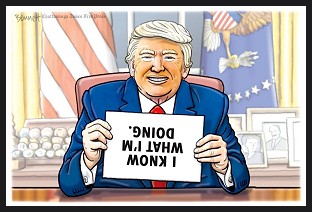 Sunday 'Zero Day' Toons
Sunday 'Zero Day' Toons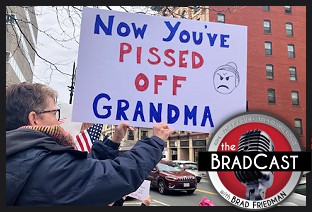 Soc. Sec. Expert Warns DOGE Hastening Collapse, Privati-zation: 'BradCast' 4/10/2025
Soc. Sec. Expert Warns DOGE Hastening Collapse, Privati-zation: 'BradCast' 4/10/2025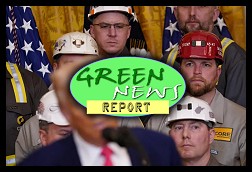 'Green News Report' 4/10/25
'Green News Report' 4/10/25
 Trump Blinks, Chaos Reigns, Markets Spike as Many Tariffs Remain Despite 90-Day 'Pause': 'BradCast' 4/9/25
Trump Blinks, Chaos Reigns, Markets Spike as Many Tariffs Remain Despite 90-Day 'Pause': 'BradCast' 4/9/25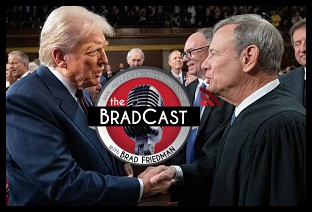 SCOTUS Deportation Ruling Grimmer Than First Appears: 'BradCast' 4/8/25
SCOTUS Deportation Ruling Grimmer Than First Appears: 'BradCast' 4/8/25 'Green News Report' 4/8/25
'Green News Report' 4/8/25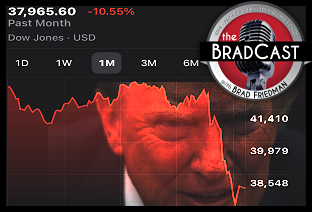 Cliff Diving with Donald: 'BradCast' 4/7/25
Cliff Diving with Donald: 'BradCast' 4/7/25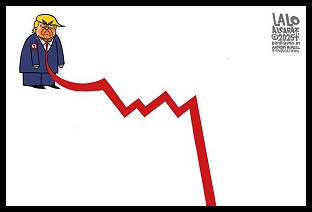 Sunday 'Don't Look Down' Toons
Sunday 'Don't Look Down' Toons 'Green News Report' 4/3/25
'Green News Report' 4/3/25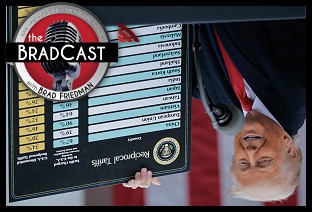 'Mob Boss' Trump's Trade Sanctions Tank U.S., World Markets: 'BradCast' 4/3/25
'Mob Boss' Trump's Trade Sanctions Tank U.S., World Markets: 'BradCast' 4/3/25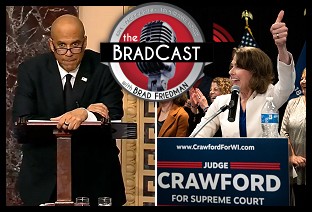 Crawford Landslide in WI; Booker Makes History in U.S. Senate: 'BradCast' 4/2/25
Crawford Landslide in WI; Booker Makes History in U.S. Senate: 'BradCast' 4/2/25 Judge Ends Challenge to GA's Unverifiable, Insecure Vote System: 'BradCast' 4/1/25
Judge Ends Challenge to GA's Unverifiable, Insecure Vote System: 'BradCast' 4/1/25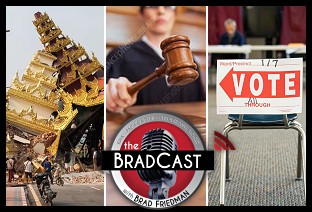 Bad Court, Election News for Trump is Good News for U.S.: 'BradCast' 3/31
Bad Court, Election News for Trump is Good News for U.S.: 'BradCast' 3/31 Vets Push Back at Plan to Slash Health Care, 80K V.A. Jobs: 'BradCast' 3/27/25
Vets Push Back at Plan to Slash Health Care, 80K V.A. Jobs: 'BradCast' 3/27/25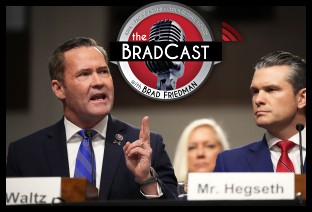 Signal Scandal Worsens for Trump, GOP; Big Dem Election Wins in PA: 'BradCast' 3/26
Signal Scandal Worsens for Trump, GOP; Big Dem Election Wins in PA: 'BradCast' 3/26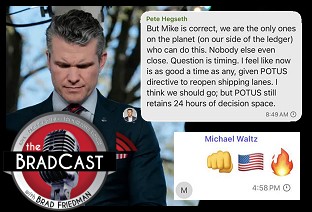 'Emptywheel': Trump NatSec Team Should 'Resign in Disgrace': 'BradCast' 3/25/25
'Emptywheel': Trump NatSec Team Should 'Resign in Disgrace': 'BradCast' 3/25/25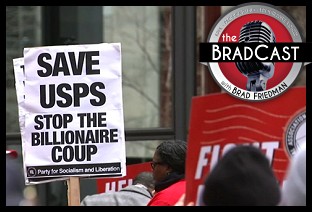 USPS 'Belongs to the People, Not the Billionaires': 'BradCast' 3/24/25
USPS 'Belongs to the People, Not the Billionaires': 'BradCast' 3/24/25
 VA GOP VOTER REG FRAUDSTER OFF HOOK
VA GOP VOTER REG FRAUDSTER OFF HOOK Criminal GOP Voter Registration Fraud Probe Expanding in VA
Criminal GOP Voter Registration Fraud Probe Expanding in VA DOJ PROBE SOUGHT AFTER VA ARREST
DOJ PROBE SOUGHT AFTER VA ARREST Arrest in VA: GOP Voter Reg Scandal Widens
Arrest in VA: GOP Voter Reg Scandal Widens ALL TOGETHER: ROVE, SPROUL, KOCHS, RNC
ALL TOGETHER: ROVE, SPROUL, KOCHS, RNC LATimes: RNC's 'Fired' Sproul Working for Repubs in 'as Many as 30 States'
LATimes: RNC's 'Fired' Sproul Working for Repubs in 'as Many as 30 States' 'Fired' Sproul Group 'Cloned', Still Working for Republicans in At Least 10 States
'Fired' Sproul Group 'Cloned', Still Working for Republicans in At Least 10 States FINALLY: FOX ON GOP REG FRAUD SCANDAL
FINALLY: FOX ON GOP REG FRAUD SCANDAL COLORADO FOLLOWS FLORIDA WITH GOP CRIMINAL INVESTIGATION
COLORADO FOLLOWS FLORIDA WITH GOP CRIMINAL INVESTIGATION CRIMINAL PROBE LAUNCHED INTO GOP VOTER REGISTRATION FRAUD SCANDAL IN FL
CRIMINAL PROBE LAUNCHED INTO GOP VOTER REGISTRATION FRAUD SCANDAL IN FL Brad Breaks PA Photo ID & GOP Registration Fraud Scandal News on Hartmann TV
Brad Breaks PA Photo ID & GOP Registration Fraud Scandal News on Hartmann TV  CAUGHT ON TAPE: COORDINATED NATIONWIDE GOP VOTER REG SCAM
CAUGHT ON TAPE: COORDINATED NATIONWIDE GOP VOTER REG SCAM CRIMINAL ELECTION FRAUD COMPLAINT FILED AGAINST GOP 'FRAUD' FIRM
CRIMINAL ELECTION FRAUD COMPLAINT FILED AGAINST GOP 'FRAUD' FIRM RICK SCOTT GETS ROLLED IN GOP REGISTRATION FRAUD SCANDAL
RICK SCOTT GETS ROLLED IN GOP REGISTRATION FRAUD SCANDAL VIDEO: Brad Breaks GOP Reg Fraud Scandal on Hartmann TV
VIDEO: Brad Breaks GOP Reg Fraud Scandal on Hartmann TV RNC FIRES NATIONAL VOTER REGISTRATION FIRM FOR FRAUD
RNC FIRES NATIONAL VOTER REGISTRATION FIRM FOR FRAUD EXCLUSIVE: Intvw w/ FL Official Who First Discovered GOP Reg Fraud
EXCLUSIVE: Intvw w/ FL Official Who First Discovered GOP Reg Fraud GOP REGISTRATION FRAUD FOUND IN FL
GOP REGISTRATION FRAUD FOUND IN FL


































